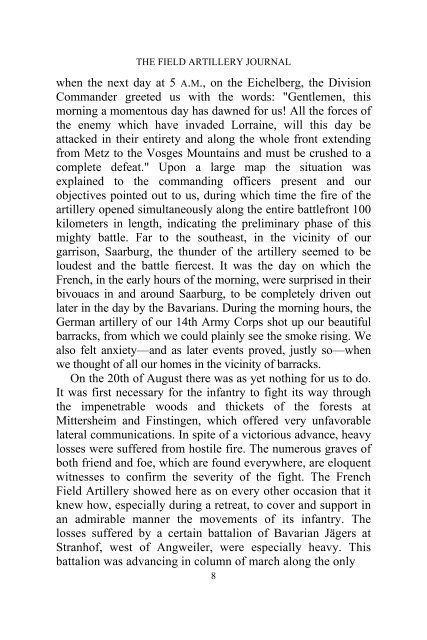the field artillery journal - Fort Sill - U.S. Army
the field artillery journal - Fort Sill - U.S. Army
the field artillery journal - Fort Sill - U.S. Army
Create successful ePaper yourself
Turn your PDF publications into a flip-book with our unique Google optimized e-Paper software.
THE FIELD ARTILLERY JOURNAL<br />
when <strong>the</strong> next day at 5 A.M., on <strong>the</strong> Eichelberg, <strong>the</strong> Division<br />
Commander greeted us with <strong>the</strong> words: "Gentlemen, this<br />
morning a momentous day has dawned for us! All <strong>the</strong> forces of<br />
<strong>the</strong> enemy which have invaded Lorraine, will this day be<br />
attacked in <strong>the</strong>ir entirety and along <strong>the</strong> whole front extending<br />
from Metz to <strong>the</strong> Vosges Mountains and must be crushed to a<br />
complete defeat." Upon a large map <strong>the</strong> situation was<br />
explained to <strong>the</strong> commanding officers present and our<br />
objectives pointed out to us, during which time <strong>the</strong> fire of <strong>the</strong><br />
<strong>artillery</strong> opened simultaneously along <strong>the</strong> entire battlefront 100<br />
kilometers in length, indicating <strong>the</strong> preliminary phase of this<br />
mighty battle. Far to <strong>the</strong> sou<strong>the</strong>ast, in <strong>the</strong> vicinity of our<br />
garrison, Saarburg, <strong>the</strong> thunder of <strong>the</strong> <strong>artillery</strong> seemed to be<br />
loudest and <strong>the</strong> battle fiercest. It was <strong>the</strong> day on which <strong>the</strong><br />
French, in <strong>the</strong> early hours of <strong>the</strong> morning, were surprised in <strong>the</strong>ir<br />
bivouacs in and around Saarburg, to be completely driven out<br />
later in <strong>the</strong> day by <strong>the</strong> Bavarians. During <strong>the</strong> morning hours, <strong>the</strong><br />
German <strong>artillery</strong> of our 14th <strong>Army</strong> Corps shot up our beautiful<br />
barracks, from which we could plainly see <strong>the</strong> smoke rising. We<br />
also felt anxiety—and as later events proved, justly so—when<br />
we thought of all our homes in <strong>the</strong> vicinity of barracks.<br />
On <strong>the</strong> 20th of August <strong>the</strong>re was as yet nothing for us to do.<br />
It was first necessary for <strong>the</strong> infantry to fight its way through<br />
<strong>the</strong> impenetrable woods and thickets of <strong>the</strong> forests at<br />
Mittersheim and Finstingen, which offered very unfavorable<br />
lateral communications. In spite of a victorious advance, heavy<br />
losses were suffered from hostile fire. The numerous graves of<br />
both friend and foe, which are found everywhere, are eloquent<br />
witnesses to confirm <strong>the</strong> severity of <strong>the</strong> fight. The French<br />
Field Artillery showed here as on every o<strong>the</strong>r occasion that it<br />
knew how, especially during a retreat, to cover and support in<br />
an admirable manner <strong>the</strong> movements of its infantry. The<br />
losses suffered by a certain battalion of Bavarian Jägers at<br />
Stranhof, west of Angweiler, were especially heavy. This<br />
battalion was advancing in column of march along <strong>the</strong> only<br />
8

















